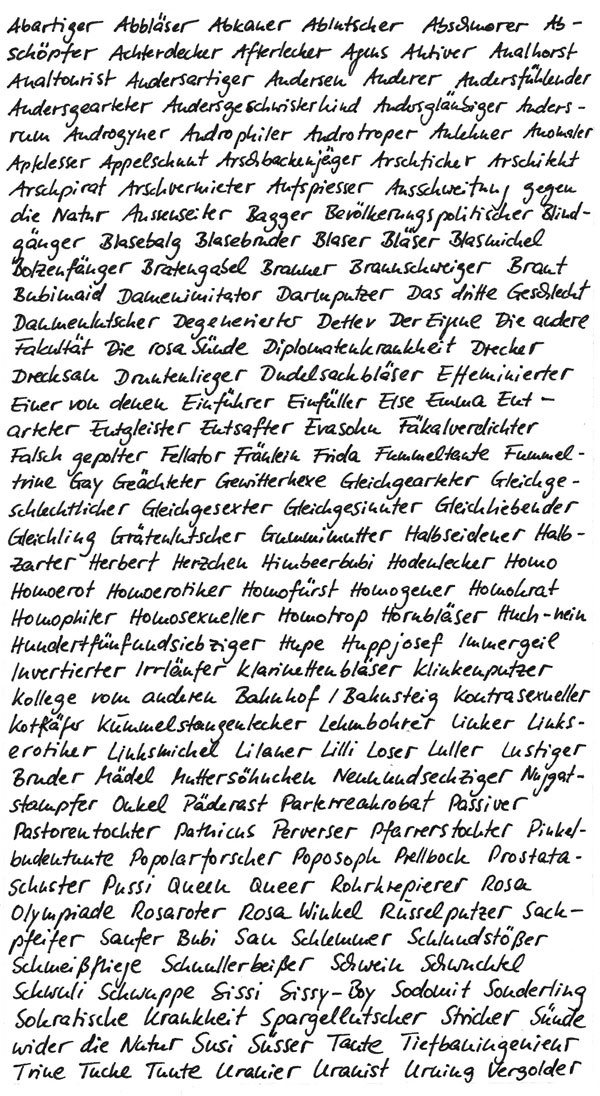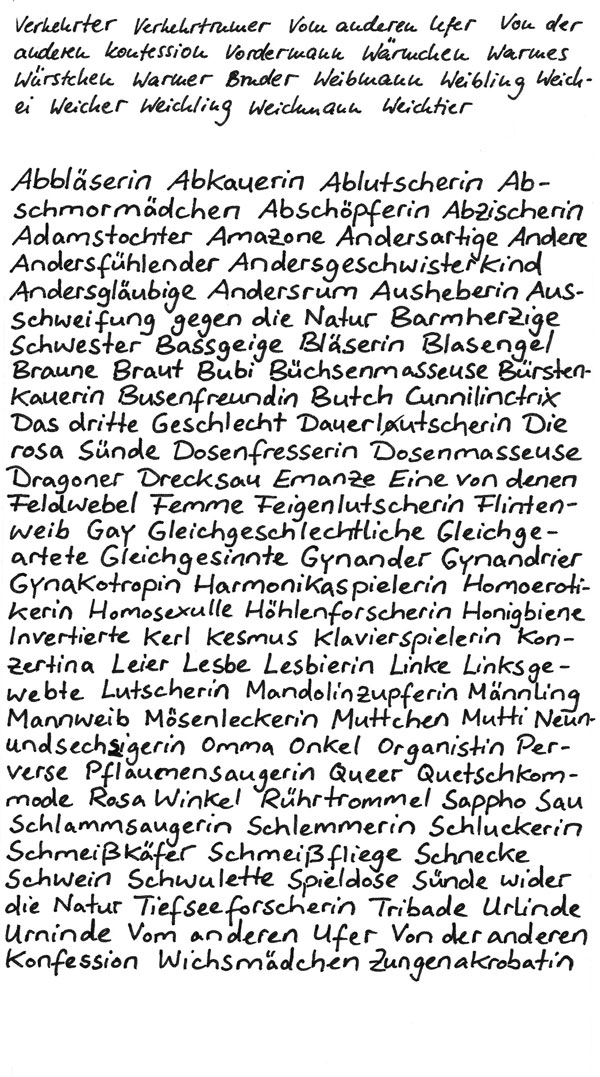IT
Questo progetto è iniziato nel 2010 quando ho cominciato a raccogliere le diverse parole usate per definire una persona in quanto omosessuale. Ho raccolto le parole delle lingue con cui ho una relazione: Italiano, la mia lingua madre, Tedesco, Inglese e Spagnolo. Per trovare le differenti parole ho cercato nel web, ho letto libri e chiesto ad amici di segnalarmi le parole che conoscevano. Dopodiché ho compilato una lista con una selezione rappresentativa delle parole raccolte. La lista è un copione per una serie di video. Fino ad ora sono state realizzate le versioni in Tedesco e in Italiano.
La struttura dei video è simile. Di fronte ad uno sfondo anonimo c’è il primo piano di una donna nello schermo a destra e il primo piano di un uomo nello schermo a sinistra. I due video sono sincronizzati. La donna elenca le parole per definire un uomo in quanto omosessuale, in ordine alfabetico, come se fossero rivolte all’uomo nello schermo accanto. Allo stesso tempo l’uomo enumera le parole per definire una donna in quanto omosessuale.
D’importanza fondamentale è il tipo di relazione che sussiste nella vita reale fra le persone riprese. Nella versione tedesca (come indica il titolo “Geschwister”), l’uomo e la donna sono fratello e sorella. Nella versione italiana, l’uomo e la donna sono migliori amici. E’ il legame d’affetto fra le persone riprese e il fatto che siano omosessuali, che permette l’uso delle parole stesse.
La lista include diversi tipi di parole: neutrali, insulti, vecchie definizioni scientifiche/mediche, termini dialettali. Il numero degli insulti è superiore rispetto agli altri termini, e in tutte le lingue sono strettamente collegate con pratiche sessuali, i genitali e con l’idea di “esclusione” e “altro”.
I termini per definire una donna omosessuale sono meno rispetto al numero di parole per definire un uomo omosessuale. Questo è chiaramente mostrato nel video. Quando l’uomo finisce di elencare le parole rivolte alla donna, rimane in silenzio, ma la ripresa continua fino a quando la donna non ha esaurito i suoi termini. Questo spazio di silenzio è la “visualizzazione” della minore rappresentazione dell’omosessualità femminile, nello stesso modo in cui in genere il femminile è meno rappresentato.
Il fatto che le persone nei video sono gay e unite da un legame di affetto depotenzia il valore negativo delle parole utilizzate. La parola è presentata nella sua forma “oggettiva”. Parola in se per sé, che non ha potere senza un sistema di riferimento, il potere è nei nostri sguardi. |
ENG
This project began in early 2010 when I started collecting different words that define a person as homosexual. I collected words of languages that I have a connection with: Italian (my mothertongue), German, English and Spanish. To find the different words I searched on the web, I read books and I asked friends to point out to me the terms that they knew. After that I drafted a list with a selected but representative number of words for each language. The list is the “script” for a series of videos. Until now two videos have been realized, the Italian version, and the German one.
The structure of both videos is similar. In front of an anonymous background there is a close up of a woman in the right screen, and a close up of a man in the left screen. The two videos are synchronized. The woman enumerates the words to define a man as homosexual, in alphabetical order, as if she were directing all that terms to the man in the screen beside hers. At the same time the man lists the words for define a woman as homosexual.
Of fundamental importance is the type of relation between the man and the woman in real life. In the German version (as the title of the video says “Geschwister”) the man and the woman are siblings. In the Italian version the man and the woman are best friends,“Migliori Amici”. It is the actual love-relation between them that allows the use of all these collected terms plus the fact that all the filmed people are gay as well.
The list includes diffent kinds of words: neutral terms, derogatory terms, old medical/scientific terminology, dialect. The number of derogatory words is higher than the rest, and in all languages they are strongly connected with sexual practices or sex organs and with the concept of “exclusion” and “others”.
The number of words to define a woman as gay is lower than for male homosexuality. That is clearly shown in the video. When the man finishes uttering the words aimed to women, he stays silent, but the shooting continues until the woman (in the other screen) finishes her list. That span of silence is the visualization of the lower representation (or consideration) of female homosexuality, as well as the representation of females in general.
The fact that the filmed persons are gay and that they are connected through fondness, takes power away from the negative connotation of the word. Words are presented in their “objective” form, just words, that without a system of reference are powerless, the power is just in our view. |
DE
Ich habe dieses Projekt im Frühjar 2010 begonnen, als ich anfing Bezeichnungen für Homosexuelle zu sammeln. Ich begann die Sammlung von solchen Wörtern der Sprachen zu denen ich eine Verbindung habe: Italiensich (meine Muttersprache), Deutsch (die Sprache meines Wohnortes), Englisch und Spanisch.
Die Worte fand ich anhand von Recherche im Internet und in Büchern und mithilfe von Interviews mit Freund_innen. Anschließen erstellte ich eine Liste mit einer repräsentativen Auswahl der recherchierten Wörter in jeder Sprache. Diese Listen sind die Scripts für vier Videos.
Bisher sind zwei der Videos realisiert worden, die italienische und die deutsche Version. Die italienische Version heißt “Migliori Amici”, Beste Freunde auf Deutsch (2 synchronisierte Videos, Loop, jedes 2,39”, 2011). Die deutsche Version heißt “Geschwister” (2 synchronisierte Videos, Loop, jedes 5,11”, 2011).
Die Struktur beider Videos ist dieselbe. Eine Frau zählt in alphabetischer Reihenfolge Bezeichnungen für homosexuelle Männer auf, als richtete sie diese Worte an den Mann neben ihr. Zur gleichen Zeit listet der Mann Wörter auf die Frauen als homosexuell definieren. Die Beziehung der beiden im wirklichen Leben ist von wesentlicher Bedeutung. Der Umstand, dass beide homosexuell sind und dass sie durch eine tiefe Zuneigung verbunden sind, nimmt den Worten ihre Kraft und ihre negative Bedeutung. Die Worte erscheinen in ihrer “objektiven” Form, sie sind nur noch Worte die, ohne eine Referenzsystem, machtlos werden. Ihre Macht liegt nur in unserem Blick.
Mein Vorhaben ist es nun auch die spanische und die englische Version zu realisieren. Spanisch ist die zweitmeist und Englisch die drittmeist gesprochene Sprache der Welt. Zu beiden Sprachen habe ich selbst eine Verbindung. Einige meiner Freund_innen sind spanischsprachig und Englisch ist die Sprache, die mir die Kommunikation mit Menschen anderer Muttersprachen als meiner eigenen ermöglicht.
Neben der Reflektion der Bedeutung von Sprache(n), fokussiert diese Arbeit Unterschiede und Ähnlichkeiten der (alltäglichen) Diskriminierung Homosexueller und die Relevanz der Beziehung zwischen Bezeichnender_em und Bezeichneter_em.
|







